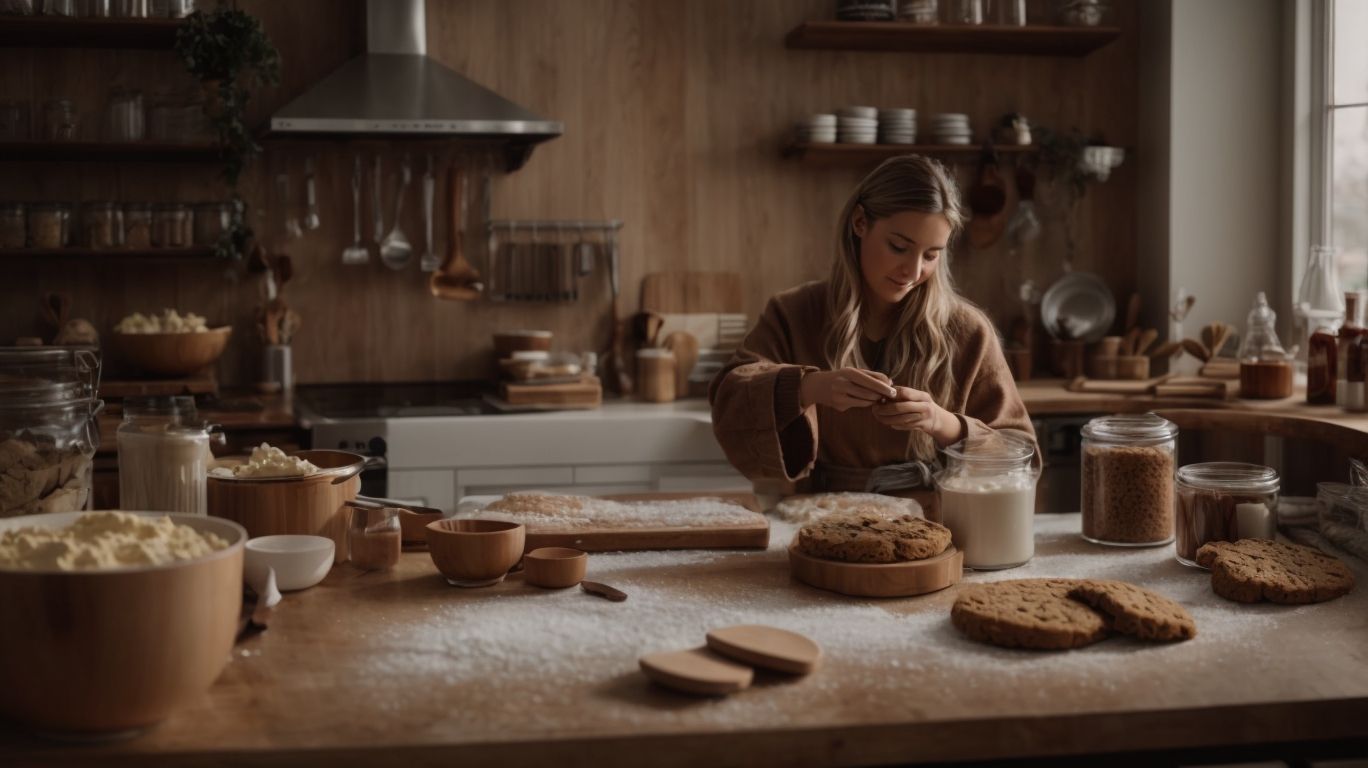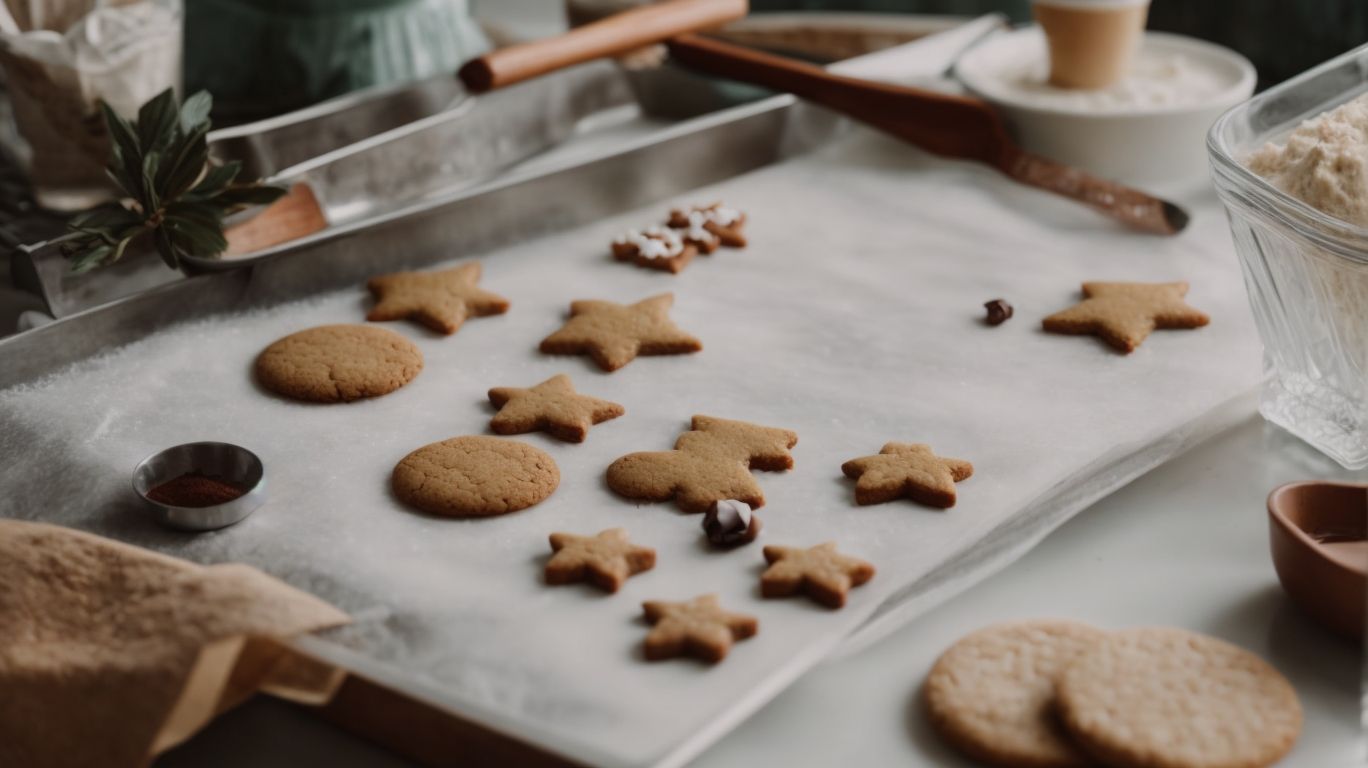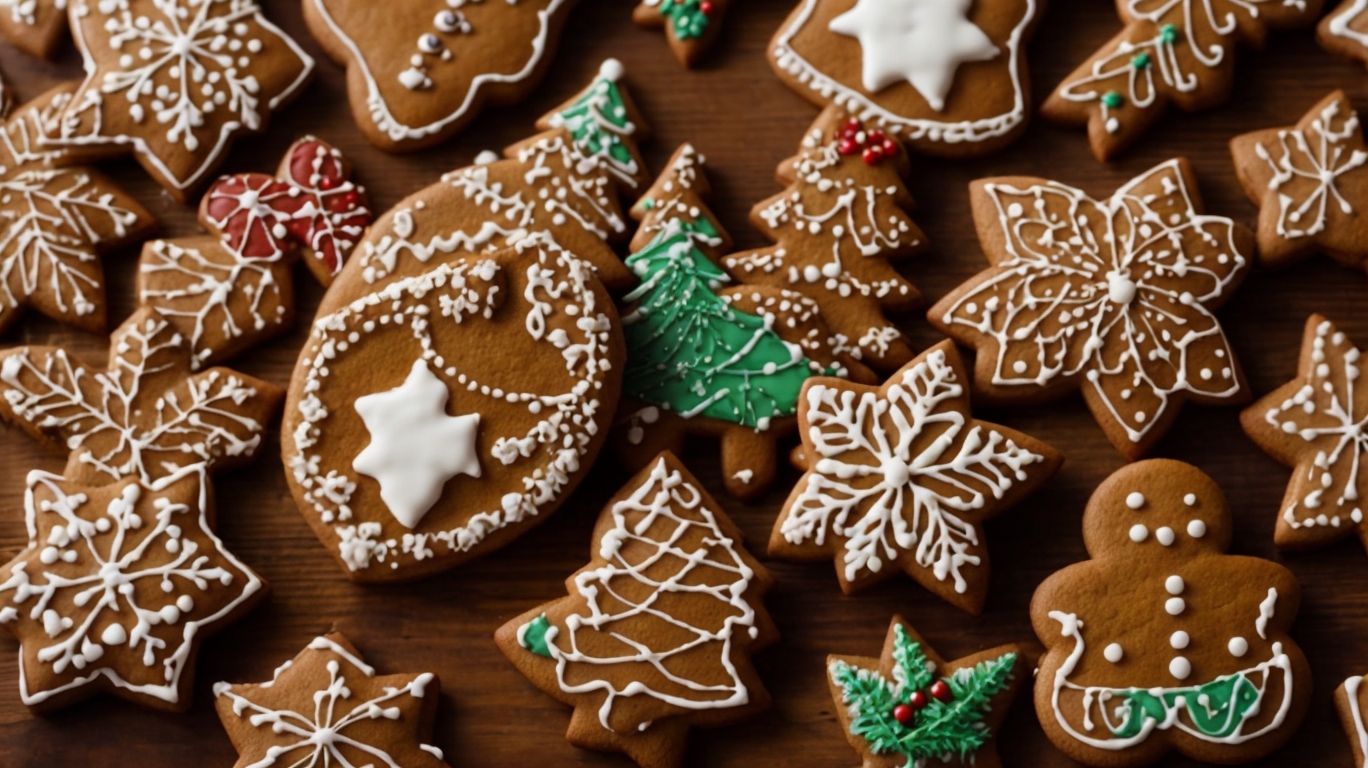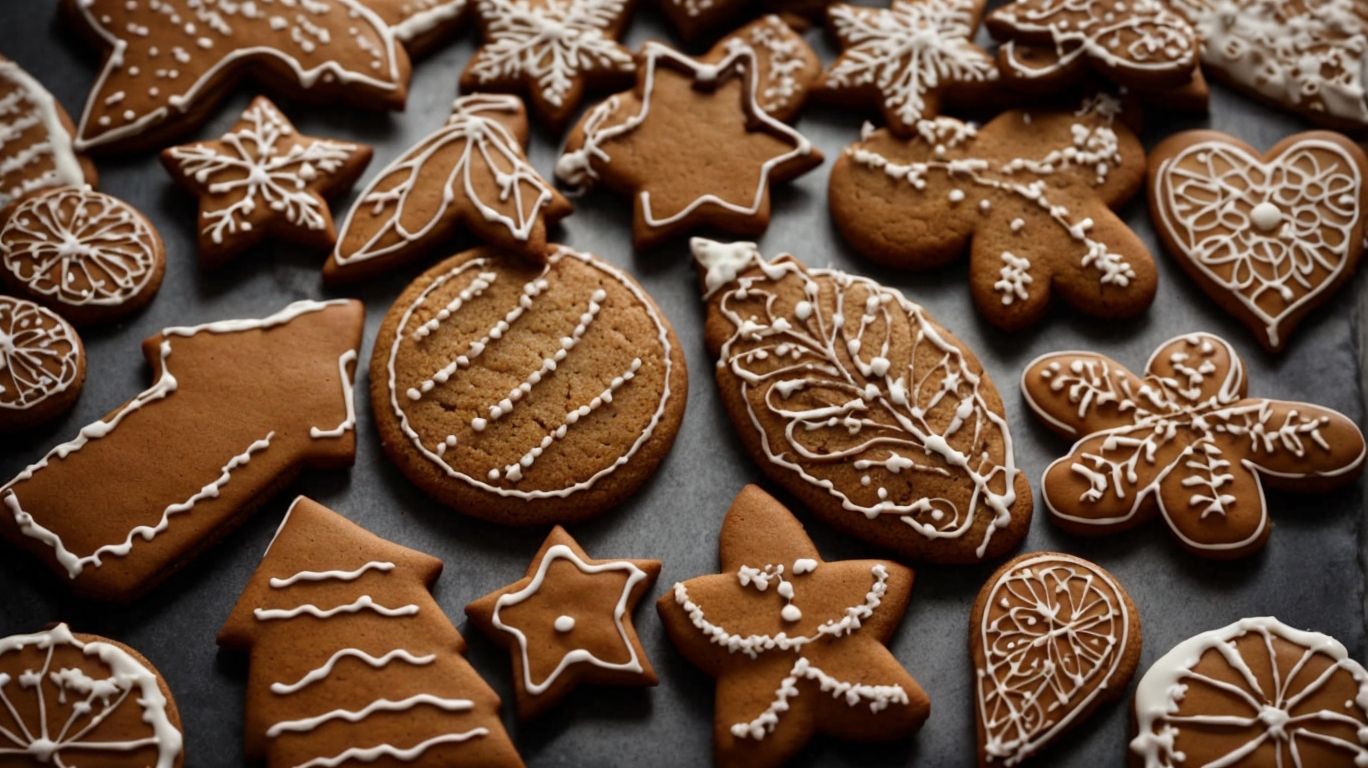How to Bake Gingerbread Cookies?
Are you ready to fill your home with the warm, spicy aroma of freshly baked gingerbread cookies?
We explore the rich history of gingerbread cookies, the essential ingredients needed to create these sweet treats, and the various types of gingerbread cookies you can enjoy.
From preparing your kitchen with the necessary tools to learning the best techniques for measuring ingredients, we guide you through the steps to bake perfect gingerbread cookies.
Stay tuned for tips on preventing spreading, keeping your cookies soft, and storing them for maximum freshness. We delve into creative variations and additions to elevate your gingerbread cookie game.
Get ready to impress your family and friends with your baking skills!
Key Takeaways:
About Gingerbread Cookies
Gingerbread Cookies, a beloved holiday treat, are a festive and flavorful addition to Christmas celebrations. These soft and chewy cookies can be decorated with a variety of festive designs and colors.
Originally, gingerbread cookies have a rich history dating back to medieval Europe, where they were often used not just for their delicious taste but also for their believed medicinal properties. Soft and chewy in texture, these cookies were traditionally shaped into various forms, such as people, animals, or seasonal objects. Today, they are synonymous with Christmas, adorning tables during the holiday season in homes worldwide.
- One of the key aspects of these cookies is the recipe itself, typically including a combination of ginger, cinnamon, nutmeg, cloves, and molasses.
- It is said that Queen Elizabeth I was known to have gifts shaped as gingerbread cookies in her likeness, a practice that helped elevate the cookies’ popularity.
The act of decorating gingerbread cookies has become an art form, with enthusiasts showcasing their creativity through intricate designs using icing, sprinkles, and edible decorations. Whether enjoyed as a festive treat or used as decorations, gingerbread cookies hold a special place in the hearts of many and remain a time-honored tradition during the holiday season.
What is the History of Gingerbread Cookies?
The history of gingerbread cookies dates back centuries, with these sweet treats becoming synonymous with Christmas festivities. The recipe for gingerbread cookies has evolved over time, incorporating a blend of spices and flavors.
Historically, gingerbread cookies were first baked in Europe during the 11th century, inspired by Middle Eastern recipes brought back by crusaders. The Crusaders brought back exotic spices like ginger, cinnamon, and cloves, which were incorporated into the traditional recipes. In the 17th century, decorating gingerbread cookies with intricate designs became popular, symbolizing prosperity and well-being.
Throughout the centuries, different cultures have put their own spin on gingerbread cookies. In Scandinavia, gingerbread cookies are often shaped like little men, while in Germany, gingerbread houses are a staple during the Christmas season.
What are the Ingredients for Gingerbread Cookies?
The key ingredients for making delicious gingerbread cookies include molasses, ginger, cinnamon, a blend of spices, flour, sugar, and butter. These elements combine to create a rich and aromatic dough perfect for baking.
Molasses, a dark, thick syrup extracted during the sugar-making process, is the star ingredient that gives gingerbread cookies their distinct rich flavor and chewy texture. Ginger adds a warm and spicy kick, while cinnamon infuses the dough with sweet warmth. The blend of assorted spices such as cloves, nutmeg, and allspice contributes to the complex and fragrant taste profile of the cookies. The right balance of sugar and butter provides sweetness and richness, enhancing the overall taste and texture of the final product.
What are the Different Types of Gingerbread Cookies?
Gingerbread cookies come in various forms, including classic gingerbread men, intricately decorated shapes, and frosted designs that capture the spirit of the holiday season. The art of decorating gingerbread cookies allows for endless creativity and personalization.
Traditional gingerbread men are often the staple of any holiday cookie collection, with their charming smiles and iconic shapes. Modern bakers have taken gingerbread cookie decorating to new heights, creating elaborate designs that range from miniature houses to delicate snowflakes.
Using tools such as piping bags, icing tips, and edible glitter, decorators can add intricate details and vibrant colors to gingerbread cookies. The process of frosting gingerbread cookies can be a therapeutic and rewarding experience, blending artistic expression with festive baking traditions.
Whether you prefer simple elegance or bold, eye-catching designs, the possibilities for decorating gingerbread cookies are truly limitless.
Preparing to Bake Gingerbread Cookies

Credits: Poormet.Com – Jesse Harris
Before diving into the baking process, it is essential to gather the necessary tools for preparing gingerbread cookies.
Properly measuring ingredients and prepping baking sheets are crucial steps for successful cookie-making.
Tools such as mixing bowls, a whisk, measuring cups, and spoons are essential for a seamless baking experience. Regarding ingredients, precise measurements can greatly impact the final taste and texture of the cookies. Ensure your baking sheets are prepared by lining them with parchment paper or non-stick spray to prevent sticking and ensure even baking. Organization is key – lay out all your tools and ingredients beforehand, following a step-by-step approach for a stress-free baking session.
What Tools Do You Need?
To bake perfect gingerbread cookies, you will need essential tools such as cookie cutters, rolling pins, baking sheets, and a mixer for blending the dough to the right consistency.
Cookie cutters come in various shapes and sizes, allowing you to create festive designs for your cookies. They give your treats that perfect shape and help them bake evenly.
A rolling pin is vital for flattening the dough to the desired thickness, ensuring consistency in your batches. It helps in spreading the dough evenly for uniform baking.
Baking sheets are necessary for placing your cookie dough onto for baking. They provide a non-stick surface and prevent the cookies from sticking, ensuring easy removal.
A mixer is essential for combining ingredients efficiently, ensuring a smooth and well-mixed dough. It saves time and effort in the mixing process.
How to Properly Measure Ingredients?
Accurate measurement of ingredients is crucial for the success of your gingerbread cookies. Use measuring cups and spoons for precise amounts of flour, sugar, baking soda, and other essential components.
When preparing gingerbread cookie dough, the right balance of ingredients can make all the difference.
Measuring accurately ensures that your cookies turn out just right – not too dense or too crumbly.
Flour, sugar, and baking soda need to be added in the correct quantities to achieve the perfect texture and flavor.
What to Do Before Baking?
Before baking the gingerbread cookies, make sure the dough is properly chilled for easy handling and rolling. It’s crucial to have the dough firm enough to maintain its shape during baking, allowing for precise cutouts and defined edges. Chilling also enhances the flavor by allowing the ingredients to meld together, resulting in a richer taste. When the dough is cold, it’s less likely to spread out excessively in the oven, leading to perfectly shaped cookies that hold their form. Taking time to chill the dough is a simple yet essential step in gingerbread cookie making.
Prepare any decorations or frostings in advance to elevate the visual appeal of your gingerbread creations. Having these elements ready beforehand not only saves time during the baking process but also ensures a smoother decorating experience. From royal icing to colorful sprinkles and edible glitter, having a variety of decorations on hand allows for creativity and customization. Consider organizing your decorations in:
- Separate containers for easy access and efficient use while decorating.
By incorporating this pre-baking preparation, you’ll be well-equipped to craft beautifully decorated and delicious gingerbread cookies that are sure to impress.
Steps to Bake Gingerbread Cookies

Credits: Poormet.Com – Anthony Miller
Baking delicious gingerbread cookies involves a series of steps, from making the dough to decorating the final creations. Each stage contributes to the overall flavor and presentation of these festive treats.
Starting with preparing the dough, the mixture of flour, spices, molasses, and ginger creates the signature flavor of gingerbread.
Rolling out the dough to the right thickness ensures that the cookies bake evenly. Using festive cookie cutters, the dough is then shaped into charming figures before placing them in the oven.
The baking process fills your kitchen with a warm, spicy aroma, signaling that the cookies are almost ready. Once baked to perfection, it’s time to unleash your creativity with colorful icing and decorative sprinkles, transforming the cookies into delightful holiday treats.
Step 1: Making the Dough
The first step in baking gingerbread cookies is preparing the dough, which involves combining flour, spices, butter, and molasses to create a fragrant and pliable mixture.
Flour serves as the base of the dough, providing structure and body. It’s essential to sift the flour before mixing to ensure a smooth consistency. The selection of spices such as cinnamon, ginger, and cloves infuses the dough with that signature warm and spicy flavor gingerbread cookies are known for.
Butter adds richness and moisture to the dough, making the cookies tender and flavorful. Molasses not only sweetens the dough but also contributes to its dark color and deep flavor profile.
To achieve the perfect dough consistency, it is important to chill the mixture before rolling it out and cutting out the cookie shapes.”
Step 2: Rolling and Cutting the Dough
After making the dough, roll it out to a consistent thickness and use cookie cutters to create shapes like traditional gingerbread men or festive designs.
When rolling out the gingerbread dough, aim for a thickness of around 1/4 inch to ensure even baking. Uniform thickness is key for the cookies to bake uniformly and hold their shape. Using a rolling pin dusted with flour, gently roll out the dough, rotating it occasionally to prevent sticking. Consider placing parchment paper underneath to prevent sticking and make transferring the cutouts easier. Remember to work swiftly to prevent the dough from becoming too warm, which can affect the final texture of the baked cookies.
Step 3: Baking the Cookies
Once shaped, bake the gingerbread cookies in a preheated oven until they are golden brown and fragrant. The baking process enhances the flavors and textures of the cookies.
Set your oven to the recommended temperature, typically around 350°F, allowing it to reach the ideal baking environment. While the aroma of warm spices fills your kitchen, keep an eye on the cookies as they slowly turn that perfect shade of golden brown, indicating a caramelized crunchiness that complements the gooey interior wonderfully.
Remember that over-baking can result in a dry, crumbly texture, so it’s crucial to monitor them closely. The cookies will firm up slightly as they cool on the pan, so resist the temptation to leave them in the oven for too long. Trust your senses; a slight touch should reveal a beautifully sturdy yet chewy consistency.
Step 4: Decorating the Cookies
The final step in creating gingerbread cookies involves decorating them with frostings, sprinkles, and other edible decorations. Let your creativity shine as you adorn the cookies with festive designs.
Regarding frosting your gingerbread cookies, the possibilities are endless. From classic royal icing to rich buttercream, choosing the right frosting can greatly enhance the appearance of your cookies.
Consider using piping bags with various tips to create intricate patterns or opt for a simple, smooth finish. Sprinkles and edible embellishments add a delightful touch to your creations. Mix and match different colors and shapes to bring your gingerbread cookies to life.
Remember, the key is to have fun and enjoy the process of decorating these sweet treats.
Tips and Tricks for Perfect Gingerbread Cookies

Credits: Poormet.Com – Roy Hill
Achieving perfect gingerbread cookies requires attention to detail and some handy tips. From preventing cookie spread to keeping them soft and chewy, these expert suggestions will elevate your baking game.
One key tip to prevent cookie spread during baking is to chill the dough before shaping and baking. This helps the cookies maintain their shape while in the oven. For a soft and chewy texture, make sure to slightly underbake the cookies as they will continue to cook once removed from the oven.
Regarding storage, store gingerbread cookies in an airtight container at room temperature with a slice of bread to help retain moisture. Alternatively, you can freeze the cookies in a freezer-safe bag, ensuring they stay fresh for longer periods. By following these tips and tricks, your gingerbread cookies will be a hit every time!
How to Prevent the Cookies from Spreading?
To prevent gingerbread cookies from spreading excessively during baking, chill the dough before shaping and decorating. This simple step helps maintain the cookie’s intended shape and structure.
Chilling the dough achieves two important goals in the cookie-making process. It solidifies the fats in the dough, primarily butter, which helps slow down the spreading of the cookies in the oven. This is crucial for preserving the intricate designs and shapes created before baking. Secondly, chilling allows the flour to fully hydrate, resulting in a more cohesive dough that is easier to work with and holds its form better.
When the dough is well-chilled, it also helps prevent excess spread by reducing the chances of gluten formation. Gluten development can lead to tough and misshapen cookies. A properly chilled dough makes it simpler to cut out precise shapes without distortion, contributing to the overall aesthetics of the final product.
How to Keep the Cookies Soft and Chewy?
For soft and chewy gingerbread cookies, avoid overbaking by removing them from the oven when slightly underdone. The residual heat will continue to cook the cookies as they cool, preserving their desirable texture.
One effective technique to achieve this perfect balance is to set a timer for the minimum recommended baking time and then check the cookies for doneness. They should look set around the edges but still slightly soft in the middle.
Another crucial tip is to use an oven thermometer to ensure accurate temperature readings, as variations can significantly impact baking results. Preheating the oven thoroughly before placing the cookies inside helps maintain a consistent baking environment.
How to Store Gingerbread Cookies?
To preserve the freshness of gingerbread cookies, store them in an airtight container at room temperature. Adding a slice of bread can help maintain moisture and extend the cookies’ shelf life.
When stored in an airtight container, gingerbread cookies are shielded from exposure to air, which can cause them to lose moisture and become stale. The bread slice acts as a natural moisture-retaining agent, preventing the cookies from drying out too quickly. Keeping the cookies at room temperature ensures that they remain at their optimum texture and flavor for a longer period. This method not only helps in maintaining the quality of the cookies but also keeps them ready-to-eat whenever cravings strike.
Variations and Additions to Gingerbread Cookies
Explore the versatility of gingerbread cookies by experimenting with unique variations and additions. From alternative flavors to gluten-free options and creative decorating techniques, there are endless possibilities to infuse innovation into your cookie creations.
Regarding alternative flavors, consider incorporating orange zest or chai spices for a twist on the classic gingerbread taste. For those seeking gluten-free options, you can substitute traditional flour with almond flour or a gluten-free baking mix to cater to dietary preferences without compromising on flavor. To elevate your decorating game, try using edible glitter, royal icing, or even mini chocolate chips to add a touch of sparkle and texture to your gingerbread creations.
What Other Flavors Can You Add to the Dough?
Enhance the flavor profile of gingerbread cookies by incorporating additional spices such as cloves, allspice, or unique extracts like almond or citrus. These flavorful additions offer a creative twist to traditional gingerbread recipes.
For a warm and comforting boost, consider adding a dash of nutmeg to your gingerbread cookie dough. This subtle spice complements the ginger and adds depth to the overall flavor profile.
- Experiment with a hint of cardamom to introduce a slightly floral and citrusy note, balancing the sweetness of the dough.
- Incorporating a touch of ground black pepper can bring a subtle heat that contrasts beautifully with the sweetness of the cookie.
For a more exotic twist, try infusing the dough with a touch of chai spices like cinnamon, cardamom, and cloves, creating a complex and aromatic blend.
How to Make Gluten-Free Gingerbread Cookies?
Craft delicious gluten-free gingerbread cookies by using alternative flours like almond, coconut, or gluten-free blends. Experiment with xanthan gum or other binding agents to maintain dough consistency and texture.
When opting for alternative flours, keep in mind their different textures and absorbency levels compared to traditional wheat flour. Almond flour can add a nutty taste and a dense texture, while coconut flour tends to absorb more liquid, requiring additional moisture in the recipe.
For those seeking a dairy-free option, consider using coconut oil or vegan butter as a suitable substitute for traditional butter. This swap can contribute to a slightly different flavor profile but maintains the desired cookie texture.
What are Some Creative Ways to Decorate Gingerbread Cookies?
Unleash your creativity with imaginative decorating techniques for gingerbread cookies, such as intricate royal icing designs, chocolate drizzles, or edible glitter accents. Personalize your cookies with unique decorations that reflect your festive spirit.
Experiment with different piping tips to create various textures and patterns on your gingerbread cookies. Mix and match colors to make your creations pop, or try using stencils for a more uniform look. If you’re feeling adventurous, consider adding small candies, sprinkles, or metallic details for a touch of whimsy.
When decorating, remember that less is often more; strategically placed details can have a big impact. Play around with different techniques such as marbling, flooding, or even airbrushing for a truly eye-catching finish. Don’t forget to let your cookies dry completely between layers to avoid smudging or blending of decorations.
Frequently Asked Questions
What ingredients do I need to bake gingerbread cookies?
To bake gingerbread cookies, you will need all-purpose flour, baking soda, ground ginger, ground cinnamon, ground cloves, salt, unsalted butter, brown sugar, molasses, egg, and vanilla extract.
Can I substitute molasses with honey in gingerbread cookies?
While molasses is the traditional sweetener for gingerbread cookies, you can substitute it with honey. However, keep in mind that honey is sweeter than molasses, so you may need to adjust the amount used in the recipe.
How do I make sure my gingerbread cookies don’t spread too much?
To prevent gingerbread cookies from spreading, make sure your butter is at room temperature and not melted. Also, chill the dough for at least 30 minutes before baking to help the cookies hold their shape.
Can I freeze gingerbread cookie dough?
Yes, you can freeze gingerbread cookie dough. Simply wrap the dough tightly in plastic wrap and place it in a freezer-safe bag or container. Thaw the dough in the fridge before using it.
How thick should I roll out the dough for gingerbread cookies?
The thickness of the dough will depend on personal preference, but typically, it should be rolled to about 1/4 inch thickness. Thicker dough will result in softer, chewier cookies, while thinner dough will make crispier cookies.
Can I decorate gingerbread cookies with icing?
Yes, you can decorate gingerbread cookies with icing. You can make your own icing using powdered sugar, water, and food coloring, or you can use store-bought icing tubes for easier decorating. Wait for the cookies to cool completely before icing them.

